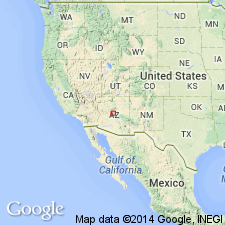
- Usage in publication:
-
- Sycamore Pass Member
- Modifications:
-
- Named
- Dominant lithology:
-
- Sandstone
- AAPG geologic province:
-
- Basin-and-Range province
- Plateau sedimentary province
Summary:
Named as an upper member of Schnebly Hill Formation (named) for extensive exposures of cross-bedded sandstone (nearly 100 percent) at Sycamore Pass, sec 24, T18N, R3E, Yavapai Co, AZ, Basin-and-Range province. Extends into the Plateau sedimentary province. Type section is along Sycamore Pass trail and along southwest ridge of Casner Mountains in Sycamore Basin and Loy Butte quads. Forms towering cliffs. Is 740 ft thick at type. Thins abruptly to northwest and southeast of type. Thinning due to facies change and intertonguing with other members of Schnebly Hill. Lower part grades into Bell Rock Member (named) of Schnebly Hill between Sycamore Pass and Bell Rock areas. Overlies Fort Apache Member (reassigned from Supai Formation) south of Sedona. Overlies Corduroy Member (reassigned from Supai) east of Beaver Creek. Overlies Hermit Formation and underlies Coconino Sandstone at its type. Intertongues with Coconino between Fossil Creek and Picacho Butte to west; at these localities contact difficult to place. Nomenclature chart, cross sections. Of Early Permian, Leonardian age. Was assigned to Supai Formation, Coconino Sandstone, and to Fort Apache Member in earlier reports.
Source: GNU records (USGS DDS-6; Denver GNULEX).
For more information, please contact Nancy Stamm, Geologic Names Committee Secretary.
Asterisk (*) indicates published by U.S. Geological Survey authors.
"No current usage" (†) implies that a name has been abandoned or has fallen into disuse. Former usage and, if known, replacement name given in parentheses ( ).
Slash (/) indicates name conflicts with nomenclatural guidelines (CSN, 1933; ACSN, 1961, 1970; NACSN, 1983, 2005, 2021). May be explained within brackets ([ ]).

